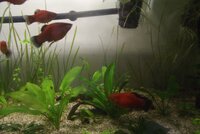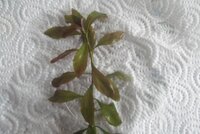Do you want to see light deficiency? I've shown these before. It's from my emersed plant setup.
Ludwiga stalk growing shaded(or should I say not growing at all...by the way it died eventually)

Now same plant a few cm to the left of this one, but growing unshaded and planted 3 months later than the above one.

Aponogeton plant growing shaded in the corner under my emersed plants. Take a note at the visual poor structure

Now below is it's brother aponogeton, picture taken same day and plant is planted a few cm further but gets full light, both plants went into the tank on the same day.

My 3 sword plants when they had enough of light before my lights failed

Now look at the exact same 3 swords and plants with 40% decrease in light, notice plants have disappeared....No other change done in the tank.

Iron deficiency in hydrophila. Can you notice the small BBA tuffs?
🙂 The bottom leaves had more BBA.

Then here is the same plant in the same tank a few weeks later with regular iron dosing

And here you can see the transition in between not dosing and after the first week of dosing, tops started growing bigger and green.

Now here is another one you may find interesting. To the right is the older growth, to the left the newer growth
The change was caused by a dose of KNO3

KNO3 mild deficiency, smaller leaves, shorter distance between nodes. High deficiency of K causes holes and melt in bottom leaves of this ludwiga so I think it's more lack of NO3.

After I dosed KNO3 for the first time the same plant converted into this form, redder leaves, longer distance between leave nodes and started growing rapidly.

















